How to Choose
Coffee Tables, End Tables & Console Tables
When you choose the right coffee table, end tables, and console tables, you achieve the perfect marriage of fashion and function. This occasional table buying guide will help you find your perfect match, so you and your living room tables can live happily ever after.
Choosing a Coffee Table
Start with a Shape
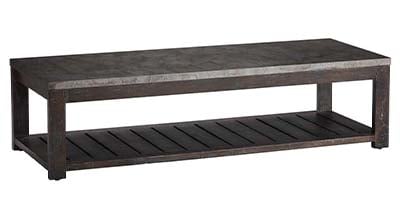
Rectangular coffee tables are a great match for almost any sofa.
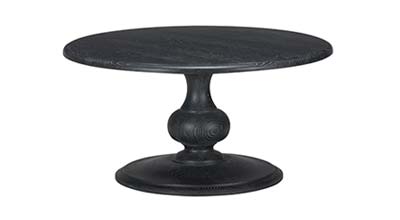
Round coffee tables add visual variety and soften the angles in your room.

Square Coffee Tables make good companions for a sectional.

Want something different? Opt for nesting tables. Placed together, they function as a regular coffee table. When you need to, you can separate them and use them in different places.
Select a Size
To determine the best size for your coffee table, start by measuring 1) the seat height of your sofa or sectional and 2) the length of your sofa or sectional.
If you’re having trouble measuring, use our 3D planner to make a layout of your living room and see how your favorite coffee table will fit, or ask one of our interior designers to make a room plan for you—the service is complimentary.

Ottomans can substitute as coffee tables and serve as extra seating in a pinch; just be aware that an ottoman is going to be shorter than a typical coffee table.
Selecting End Tables
To Match or Not to Match?

End tables that contrast with your coffee table, whether they’re a different shape, a different material, or just a slightly different finish, can give your living room a curated, collected look.

End tables that match your coffee table require no interior design guesswork. They’re the perfect plug-and-play solution for pulling your living room décor together.
Choosing the Right Size

Short on space? Try this dynamic duo: a small accent table and a floor lamp. They’ll provide a place to rest a beverage as well as task lighting, even when you don’t have much room to spare.
Picking a Console Table or Sofa Table
Console tables, because they’re narrower, are the cornerstones of entryway and hallway décor. If you want to float your sofa in the middle of your living room, you can also place a console table behind it; it hides the back of your sofa and helps to define the space.
Rectangular vs. Demilune

A rectangular console holds plenty of items on top and is easy to fit into almost any space.

Want to switch things up or go for a softer look? Try a console table with a curved demilune profile.
Want a WFH spot with a view? A console table can give you a view of all that’s happening in the living room while doubling as a laptop desk. We’ve even created some desks designed to double as consoles: See Clarendon and Reid.
Open vs. Closed

An open console table has a lighter, airier look, and may or may not come with one or more shelves which you can use to display collectibles.
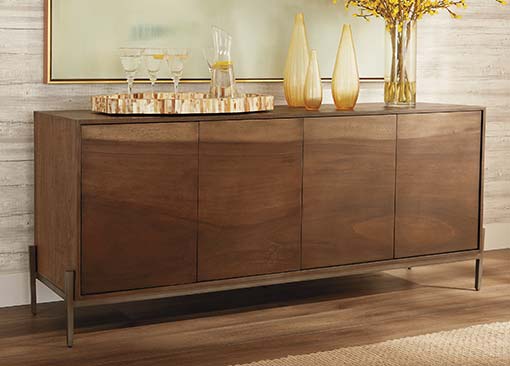
A console with a cabinet or storage drawers keeps items discreetly hidden. A small dresser or chest can also do double-duty as a closed console.
Need extra seating? Opt for an open console table and tuck some small ottomans beneath it. Then, pull out your ottomans whenever company comes over.
Think about Size
If your console table is going behind a sofa, it should be no taller than the back of the sofa and about 2/3 the length of the sofa.
In an entryway or hallway, any length that fits is okay. Just make sure you check the depth of the console table so it doesn’t come too far forward and interfere with traffic flow.

Looking for something as tall as a console table but less wide? A bar cart can fill those tight corners and make space for your spirits—or you can use its shelves to display and store other items.
Choosing Materials for Your Occasional Tables

Wood occasional tables can go formal or casual: formal in rich, dark finishes with artisan veneer work; casual in simpler wire-brushed or distressed finishes.
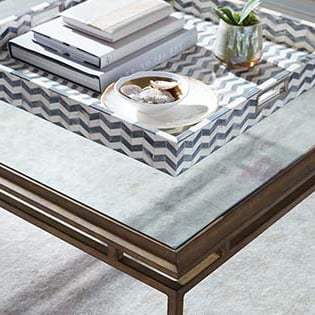
Glass-top occasional tables have less visual weight and can help a small space feel larger.

Stone-top occasional tables are a great way to introduce textural variety into any space.
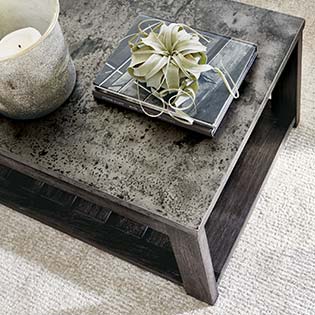
Metal-top occasional tables can give your living room a modern, industrial feel.
Have questions? Visit your local Design Center or click Designer Chat.
